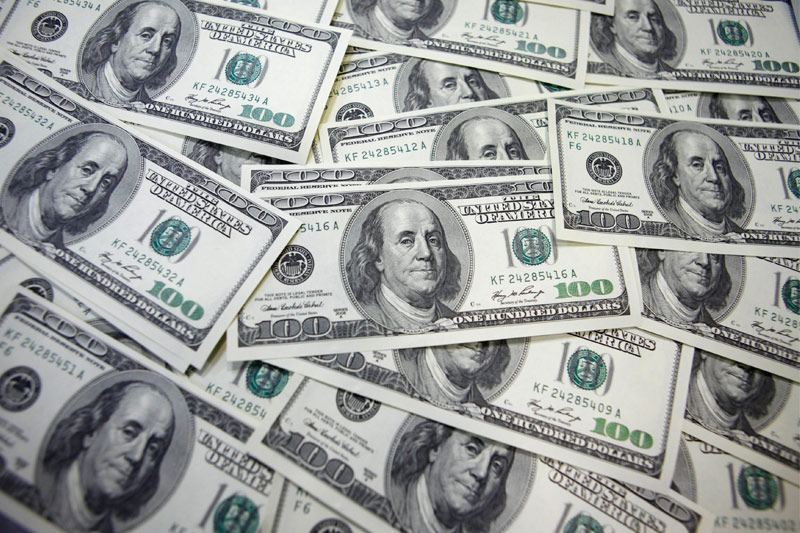Investing.com - The dollar was broadly lower against the other major currencies on Tuesday as investors looked ahead to the Federal Reserve’s latest policy decision, while U.S. data showed that consumer prices rose less than expected last month.
During European afternoon trade, the dollar was fractionally higher against the yen, with USD/JPY inching up 0.09% to 99.15.
The dollar remained under pressure ahead of the outcome of the Fed’s two-day policy meeting on Wednesday, amid expectations for a small reduction to the bank’s USD85 billion-a-month stimulus program.
The dollar showed little reaction after data showed that U.S. consumer prices rose 0.1% in August, below forecasts for a 0.2% increase.
Consumer inflation rose by 1.5% on a year-over-year basis, undershooting expectations for a 1.6% gain.
Core inflation edged up 0.1% in August, bringing the annual rate of core inflation to 1.8%, in line with forecasts.
Elsewhere, the euro was higher against the dollar, with EUR/USD up 0.21% to 1.3361.
The single currency was boosted after a report showed that the closely watched ZEW index of German economic sentiment rose to the highest level since April 2010 in September.
The German ZEW index rose to 49.6 in September from 42.0 last month, on the back of the improved economic outlook for the euro zone. Analysts had forecast a reading of 46.0.
The pound eased back from almost eight-month highs against the dollar, with GBP/USD up just 0.01% to 1.5899 after data showed that U.K. consumer price inflation ticked down to 2.7% on a year-over-year basis in August from 2.8% in July.
The dollar was lower against the Swiss franc, with USD/CHF sliding 0.15% to 0.9260.
Elsewhere, the greenback was weaker against its Australian, New Zealand and Canadian counterparts, with AUD/USD rising 0.36% to 0.9351, NZD/USD up 0.54% to 0.8214 and USD/CAD slipping 0.12% to 1.0311.
The minutes of the Reserve Bank of Australia’s September meeting said Tuesday that further rate cuts remain possible but are not imminent and added that a further decline in the Australian dollar would be “helpful” to the economy.
The dollar index, which tracks the performance of the greenback versus a basket of six other major currencies, was down 0.14% to 81.31.
During European afternoon trade, the dollar was fractionally higher against the yen, with USD/JPY inching up 0.09% to 99.15.
The dollar remained under pressure ahead of the outcome of the Fed’s two-day policy meeting on Wednesday, amid expectations for a small reduction to the bank’s USD85 billion-a-month stimulus program.
The dollar showed little reaction after data showed that U.S. consumer prices rose 0.1% in August, below forecasts for a 0.2% increase.
Consumer inflation rose by 1.5% on a year-over-year basis, undershooting expectations for a 1.6% gain.
Core inflation edged up 0.1% in August, bringing the annual rate of core inflation to 1.8%, in line with forecasts.
Elsewhere, the euro was higher against the dollar, with EUR/USD up 0.21% to 1.3361.
The single currency was boosted after a report showed that the closely watched ZEW index of German economic sentiment rose to the highest level since April 2010 in September.
The German ZEW index rose to 49.6 in September from 42.0 last month, on the back of the improved economic outlook for the euro zone. Analysts had forecast a reading of 46.0.
The pound eased back from almost eight-month highs against the dollar, with GBP/USD up just 0.01% to 1.5899 after data showed that U.K. consumer price inflation ticked down to 2.7% on a year-over-year basis in August from 2.8% in July.
The dollar was lower against the Swiss franc, with USD/CHF sliding 0.15% to 0.9260.
Elsewhere, the greenback was weaker against its Australian, New Zealand and Canadian counterparts, with AUD/USD rising 0.36% to 0.9351, NZD/USD up 0.54% to 0.8214 and USD/CAD slipping 0.12% to 1.0311.
The minutes of the Reserve Bank of Australia’s September meeting said Tuesday that further rate cuts remain possible but are not imminent and added that a further decline in the Australian dollar would be “helpful” to the economy.
The dollar index, which tracks the performance of the greenback versus a basket of six other major currencies, was down 0.14% to 81.31.
